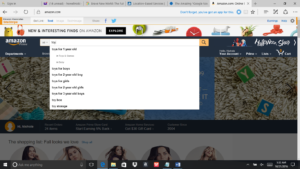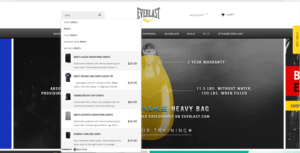It’s happened to all of us. You’re shopping online, you type what you want into the search box — and nothing comes up. In some cases, you know the retailer has the product, but the search feature simply isn’t working correctly. At this point, you may do a couple of things. You may go hunt for the product using the navigation menu, which is time-consuming and leaves you frustrated. Or, more likely, you’ll leave the site for a competitor with better search functionality.
Companies know that providing an excellent customer experience is at the heart of their success. Seventy-eight percent of marketing professionals say they try to differentiate through customer experience. A major element of a stellar customer experience is a frictionless search process. Better search communicates to your customers, “We value your time, so we’re going to make shopping with us super easy.” In fact, 77 percent of U.S. adults say that valuing their time is the most important thing a company can do to provide them with good service.
The best way to value your customers’ time is to predict precisely what they are searching for and serve it up at exactly the right time. Over the past 25 years predictive search has advanced and evolved toward the goal of giving customers a perfectly predictive shopping experience. Sergei Brin, co-founder of Google, recently said, “My vision when we started Google 15 years ago was that eventually you wouldn’t have to have a search query at all.” Advancements in predictive search are turning this vision into a reality. Let’s take a look at the evolution of predictive search and see what the future holds.
The Early Days of Search
Today the Internet is full of digital natives. If you’ve ever seen a 5-year-old ask his parent, “Why are you typing into Google? Hit that button and talk instead — it’s faster,” you know the progression.
Travel back in time, though, and you’ll find search features that would feel prehistoric today.
Archie was the very first search engine, launched over 25 years ago. Back then, locating pages through search required that you type the page name exactly how it appeared. Spelling mistakes? No results. Using different words to describe the page? No results. Missing a single word? You get the point. The phrase had to be an exact match or the searcher was left empty-handed.
Fast-forward, and today’s technology has advanced significantly. But companies are still working toward providing even more relevant and contextually engaging search experiences — especially with the advent of smartphones.
Mobile Arrives in Full Force
Mobile phones weren’t new in 2007, but that was the year the smartphone took customers by storm. The Academy Awards got a sneak peek into the technology when Apple ran its first ad, titled “Hello.” Check out the ad to see how far we’ve come.
But even Steve Jobs couldn’t anticipate how that single innovation would forever change not only mobile, but search.
As the new technology took hold, people were no longer searching for products and services only on their desktops or laptops. They were searching while waiting in line at the local coffee shop, sitting at the airport, or riding the morning commuter train. This amped up the potential rewards for companies who could crack the code on search.
If brands could predict what customers wanted to search for next, this could have a serious impact on the customer experience. For example, what would happen if companies could present search term suggestions before a person even thought to search?
The Early Days of Predictive Technologies
Thus began the advent of predictive technologies, such as Google Suggest, which in 2008 began predicting what customers were likely to type into the search box. It took inventory of all the searches a person performed online, then meshed that data with popular search results. As a result, a search for “dogs” on Google, would now auto-suggest breeds of dogs that you’d searched for in the past, or the most popular breeds. It was a small change that made a large impact.
Prior to Google Suggest (which became Google Instant), it took from nine seconds to as long as 90 seconds to manually key in search requests. After the launch of Google Instant, search times got much faster. Google estimates it’s saved searchers 3.5 billion seconds each day with this method of search.
Today many companies use similar search functionality on their e-commerce sites. A good example is Amazon. Let’s say that you type “toy” into Amazon’s search box. Amazon auto-suggests commonly searched phrases such as “toys for 1 year old” and “toys for 2 year old boy.” Suggestions take shoppers where they want to go faster, and as a result, conversions and revenue are greater.

Link: http://www.amazon.com/
Sporting goods retailer, Everlast Worldwide, has a similar feature on its e-commerce site, but using patented Rich Auto Complete™ technology from SLI Systems, Everlast takes the power of predictive search one step further. As you begin typing the word “shorts” into the search box on the Everlast website, not only are you offered immediate suggestions of “men’s shorts,” “women’s shorts” and “MMA shorts,” you’ll also see pictures, descriptions and pricing of relevant, popular products displayed right alongside the search suggestions. Although the visual autocomplete technology was launched in 2010, SLI has been improving it for over 6 years to enhance the power of prediction with visual cues. Since implementation, Everlast’s revenue from search grew from 1% to 10% of total revenue.

Link: http://www.everlast.com/
Location Awareness: Understanding Customers in Context
When location services became available on smartphones, it provided another opportunity for predictive search to produce even smarter results.
For example, using location, Google can now answer questions in context at the exact moment of relevance. So if you’re shopping at a local mall, it’s getting late, and you want to know what time stores are closing, you can simply ask your smartphone, “What time does this mall close?” Prior to location services, this question would have been too vague to retrieve an answer through regular search capabilities. How could the phone possibly know what mall you were referring to? But with location awareness, the search query can be processed because the search engine knows where you are located.
Seventy-four percent of adults use their phones to get directions or other information based on their current location. In addition, many people are using applications that rely on location to share information with friends. For example, the popular application “Find My Friends” allows you to find a friend’s exact location when both of you are connected through the app.
Location awareness provides additional power to predictive search capabilities by giving customers access to the products and services they need at the exact moment of relevance.
Predictive Search: What Is It?
Predictive search helps users find results faster and discover answers to questions they haven’t thought of yet (but likely would in the future). For example, Google Now launched in the summer of 2012. It was coined a “predictive personal assistant for Android and IoS,” but this technology is basically using predictive search to generate answers to customer questions in context.
The technology leverages all Google products that a person uses to learn more about them. It harnesses behavioral data from Gmail and google calendars, for instance, to predict what you want next.
The system learns where you live, work and travel, what television shows you like, what music you enjoy, and other critical details to serve up relevant experiences through e-commerce personalization. Essentially, Google is searching before you even think of it. But how does this type of predictive search work?
For Google Now, programmers create what they call “cards.” They use these cards to continually gather details about your life so they can produce better search experiences. So when you get in the car to head to the airport, the Google Now app automatically pulls up directions and estimated travel time to the airport before you even make the search inquiry.
The result? You just saved time, as Google accurately understood your search needs in context.
If you’re traveling to another country and need to know the exchange rate of the U.S. dollar, the moment you land, the app will welcome you and provide the weather, the exchange rate, and other details you may need. It has effectively anticipated your needs at the moment of relevance.
Predictive search can also track previous behaviors to predict future search needs. For example, if you typically view movie listings every Friday after work, predictive search will automatically deliver movie listings at 5 p.m. each Friday — before you make the search query yourself.
Behind the Scenes: A Quick Look
Predictive search will continue to evolve, but here’s how it’s currently working for search applications such as Google Now. The technology pulls data from several critical sources, including:
- Location. Where are you located right now? What is the history of your locations? The technology leverages this information to predict what you’ll want to search for in the future.
- Search details. What have you searched for in the past? This data may provide answers on what you want in the future, so predictive technology stores that for later use.
- Email. Google Now recognizes flight confirmations in your email. The example above showed how the app knew at the exact time of relevance when you would need travel time and directions to the airport.
- Calendar. When you mark events on your calendar, the technology can anticipate that you need to shop for upcoming events, such as birthdays, anniversaries or holidays.
All this data is inventoried, stored and used in conjunction with location-relevant data to anticipate your needs quickly and accurately.
Predictive Search: Does Your Company Need It?
The examples above show how people are using search technologies, such as Google Now, to find the information they need. But how does this work for e-commerce? Predictive customer analytics technologies are critical to forging stronger and authentic connections with customers.
For example, a customer could be visiting a brick-and-mortar store and looking for a product that’s out of stock. Predictive technology would know that the product is out of stock, immediately ask if the customer wants it sent directly to his or her home and offer expedited shipping to get it there the next day. Additionally, predictive technology gives you the insights to suggest relevant alternatives to the out-of-stock item.
Or, if a customer shopping online is getting close to the checkout process, predictive technology can pull up data showing this person ordered a birthday gift for a family member at the exact same time last year. The search technology could ask if they need to shop for that person again, or whether he or she wants the items in their cart gift-wrapped at a discounted price. Creating these hyper-personalized experiences through predictive search is powerful for e-commerce.
Moving Forward With Greater Accuracy
Predictive search is helping companies tap into their customers’ needs with increased accuracy. Combining historical, current and geographical data allows companies to serve up contextually relevant results before the customer thinks to make the request.
In the future, search will transform as machine learning continues to use the infinite data points that it collects to get smarter. As Jeff Bezos, founder of Amazon, said, “If you’re competitor-focused, you have to wait until there is a competitor doing something. Being customer-focused allows you to be more pioneering.” Companies that adopt this technology early will become stronger as they facilitate these targeted moments of serendipity with customers.
SLI Learning Search®
SLI Systems accelerates e-commerce with an easy to use, predictive product discovery platform that learns from customer behavior. With a more direct path to purchase, SLI helps global e-commerce retailers create a truly extraordinary buyer experience by predicting which items each shopper is most likely to buy. To learn more about how our platform grows sales and delights customers, download The Quick Guide to Better Site Search.








